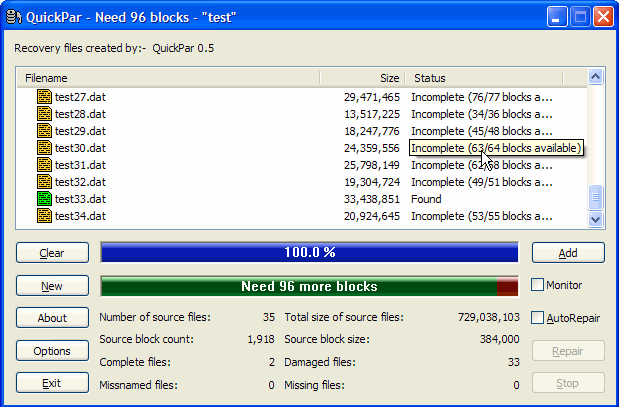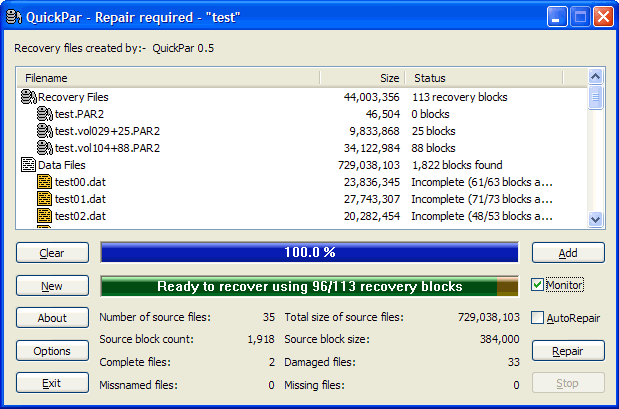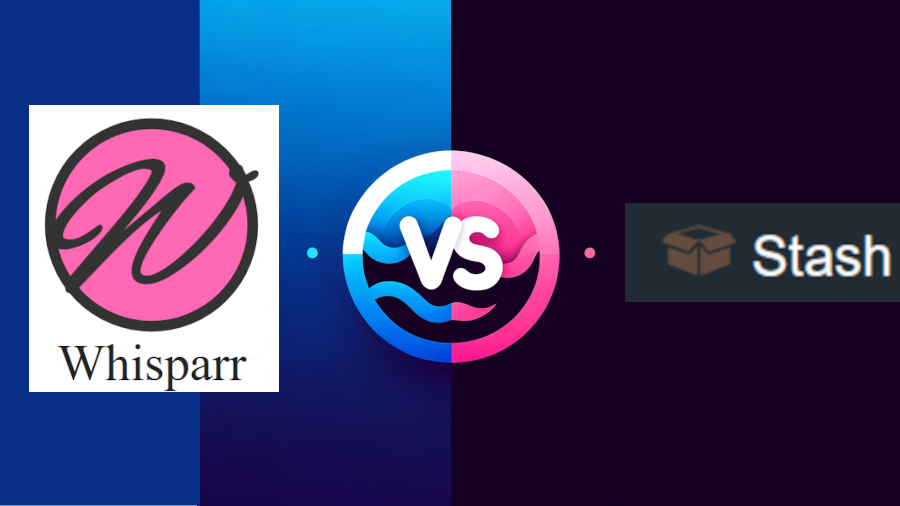
Struggling with corrupt downloads can be a hassle, but QuickPar steps in as your handy toolkit for file recovery, ensuring no piece of data is left behind.
Harness its power to create PAR2 files easily, maximizing the integrity of your transfers in the unpredictable realm of Usenet.
Since QuickPar hasn’t been updated for 19 years, take a look at MultiPar, a maintained alternative to QuickPar, to keep your files complete.
Key Takeaways
- QuickPar easily creates and manages Usenet PAR2 files, ensuring data protection.
- QuickPar fixes corrupt downloads.
- Manage Usenet PAR2 files with QuickPar.
- QuickPar’s interface makes PAR2 creation easy.
- QuickPar auto-verifies repaired files.
- Try the successor MultiPar which supports modern GPU rendering.
To use QuickPar for verifying and repairing data files, follow these steps:
How to use QuickPar to Repair and Verify Files
Get QuickPar up and running by opening a PAR2 file and let it begin its automatic scan for integrity. If it finds any issues, simply follow the below steps.
1. Opening a PAR2 File
You can start by double-clicking a PAR2 file in Windows Explorer, or right-clicking and choosing “Open with QuickPar.” Alternatively, you can open QuickPar and click the “Open” button. QuickPar will then analyze the PAR2 files and verify the protected files.

2. Verifying and Repairing
QuickPar will immediately begin the process of verifying the files that the PAR2 files protect. It will check for any corrupt or missing parts of the data files.

3. Rebuilding Missing Parts
If you encounter a situation where you have downloaded some, but not all, parts of a RAR archive, PAR2 files can help you rebuild the missing parts of the RAR. Downloading enough PAR2 files will enable you to reconstruct the missing RAR parts.

Once you get two PAR2 files totaling 113 recovery blocks, QuickPar shows you can fix the files using 96 blocks. Just hit “Repair” to start.
When you begin fixing files, QuickPar renames the damaged ones, adding “.1” at the end. After fixing, it automatically checks the repaired files to make sure everything’s in order.

QuickPar is a valuable tool for maintaining the integrity of files shared over the alt.binaries newsgroups, ensuring your downloads are complete and reliable. It provides a simple and effective way to work with PAR2 files.
Understanding PAR2 Files
PAR2 files serve as a safeguard, essential for maintaining the integrity of files shared over the Usenet network. These files are crucial for Usenet posting, folks. Why? Well, they kick in when your downloads go south – think incomplete data or corruption. PAR2 files get to work, patching up those gaps, giving you a complete, uncorrupted file. It’s all about keeping things smooth and reliable.
Understanding the purpose of PAR2 files in Usenet posting is simple – they’re your backup, your plan B. If something messes up your files while sharing, these little heroes fix it.
The Role of QuickPar
QuickPar emerges as an indispensable tool for Usenet enthusiasts, streamlining the creation and management of PAR2 files with ease and efficiency. The benefits of using QuickPar for PAR2 creation are plenty. It’s a user-friendly solution that simplifies the process of repairing and verifying files, ensuring your downloads are complete and uncorrupted.
When troubleshooting common issues with QuickPar, the community forums and help resources are just a click away. Here’s a quick glance at what QuickPar offers:
| Feature | Benefit | Troubleshooting |
|---|---|---|
| Easy Interface | Simplifies PAR2 creation | Guides available |
| Repair Function | Fixes corrupt Usenet binaries | Community support |
| Verification | Ensures file integrity | Integrated help system |
Embrace the freedom to share and download with confidence, thanks to QuickPar’s robust capabilities.
How to create PAR2 files?
Create par2 files with QuickPar by selecting ‘Add Files’ and choosing one or multiple files. Adjust the ‘Redundancy’ setting to 10% with the blue slider for optimal protection, keeping in mind that higher redundancy increases ‘Recovery Data Size’ and creation time.

Configuring Redundancy Settings
When configuring redundancy settings in QuickPar, users can determine the level of protection needed for their files against potential Usenet download issues. It’s all about striking the right balance between file size and recovery capabilities.
Here are the steps to nail it:
Choose the number of blocks: More blocks mean more precision in repairs but a larger PAR2 file size.
Set the block size: This affects the granularity of the recovery process.
Decide on redundancy level: A higher percentage offers more safety nets.
Review and adjust: Always double-check settings before creating PAR2 files.
Configuring block allocation and troubleshooting par2 creation is straightforward with these user-friendly pointers. Keep your Usenet experience smooth and your data secure with just a few clicks.
QuickPar – Need more blocks – Selecting Recovery Block Size
Determining the appropriate recovery block size in QuickPar is a crucial step for creating efficient PAR2 files. When configuring block allocation, you’re in the driver’s seat, ensuring that your Usenet uploads are bulletproof. Pick a size that’s too small, and you might waste time troubleshooting par2 creation later. Go too big, and you could be overkilling it with unnecessary data.
To determine the right recovery block size in QuickPar, consider these options:
- Variable (powers of 2 sizing scheme): Each successive PAR2 file will be twice as large as the previous one.
- Variable (limited to size of largest data file): Similar to the first, but the largest PAR2 file won’t exceed the size of the largest RAR file.
- All the same size: Sets all PAR2 parts to the same size.
Here’s a simplified table to understand when to use each QuickPar recovery block size option:
| Option Type | Best Use Case |
|---|---|
| Variable (powers of 2 sizing scheme) | Ideal for users who want a simple way to select the right amount of recovery blocks for RAR repair. Each successive PAR2 file is double the size of the previous, making it easier to choose the right file. |
| Variable (limited to size of largest data file) | Similar to the first option, but caps the largest PAR2 file at the size of the largest RAR file. Useful for controlling file sizes while still offering a range of recovery options. |
| All the same size | Best for situations where uniform PAR2 file sizes are desired. Each PAR2 part is the same size, simplifying the repair process. |
Verifying PAR2 Integrity
To ensure your PAR2 files are functioning correctly, it’s essential to perform a verification check immediately after creation. Verifying PAR2 files is a breeze, folks. Think of it like giving your car a quick once-over before a road trip – it’s about peace of mind. If you hit a snag, troubleshooting PAR2 creation is just part of the journey to freedom from data corruption.
To verify PAR2 file integrity in QuickPar, follow these steps:
- Open QuickPar and load the PAR2 file along with its associated files.
- QuickPar will automatically begin verifying the integrity of the files.
- If the files are intact, QuickPar will show a success message; if not, it will indicate which files need repair.
- Use QuickPar to repair any damaged files as indicated.
- Re-verify after repair to ensure all files are now intact.
Right-Click Menu Creation
Effortlessly integrating into your workflow, the right-click menu option in QuickPar allows for swift creation of PAR2 files without opening the main program interface. This nifty feature means less fiddling with windows and more getting things done. Just a simple right-click on your selected files, hit ‘Create Recovery Volumes’, and you’re on your way to safeguarding your Usenet uploads.
If you’re using QuickPar on Mac, remember that setup might differ from Windows, but the convenience remains. Encounter any hiccups? Troubleshooting QuickPar errors is usually straightforward—check the FAQs or hit up some forums. The community’s got your back, ensuring your path to file protection is as smooth as possible.
Frequently Asked Questions
What file formats can PAR2 files support besides RAR?
PAR2 files protect and repair, ensuring file integrity checks span multiple formats beyond RAR, such as AVI, MKV, and MP3. They offer multi-format support, safeguarding a variety of digital content against corruption.
What to do when QuickPar shows insufficient recovery blocks for repair?
When QuickPar indicates a recovery block shortage, you must create additional recovery blocks to repair the damaged file, ensuring the file’s integrity and usability are restored for unrestricted access.
Can you automate PAR2 file creation for Usenet uploads, and which tools or scripts work best?
Yes, automating PAR2 file creation for Usenet uploads is feasible. Tools like par2cmdline allow automated scheduling and script customization, catering to those valuing freedom and efficiency in their regular upload routines.
Do QuickPar-created PAR2 files have compatibility issues with other PAR2 utilities or Usenet clients?
PAR2 files created with QuickPar generally perform well across different platforms, with no major compatibility issues reported after thorough cross-platform testing by users seeking flexibility in their Usenet experiences.
Can PAR2 file redundancy be adjusted post-creation or do you need to make new ones?
Adjusting the redundancy in PAR2 files post-creation isn’t possible. To alter the redundancy level, one must generate new PAR2 files, as current PAR2 recreation processes do not support after-the-fact adjustment limitations.




